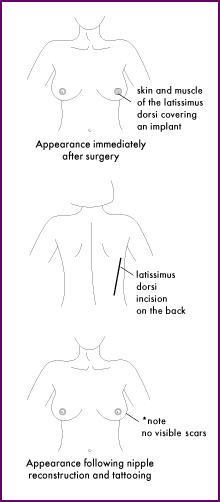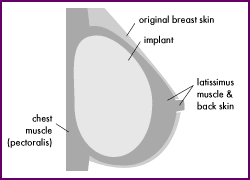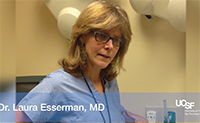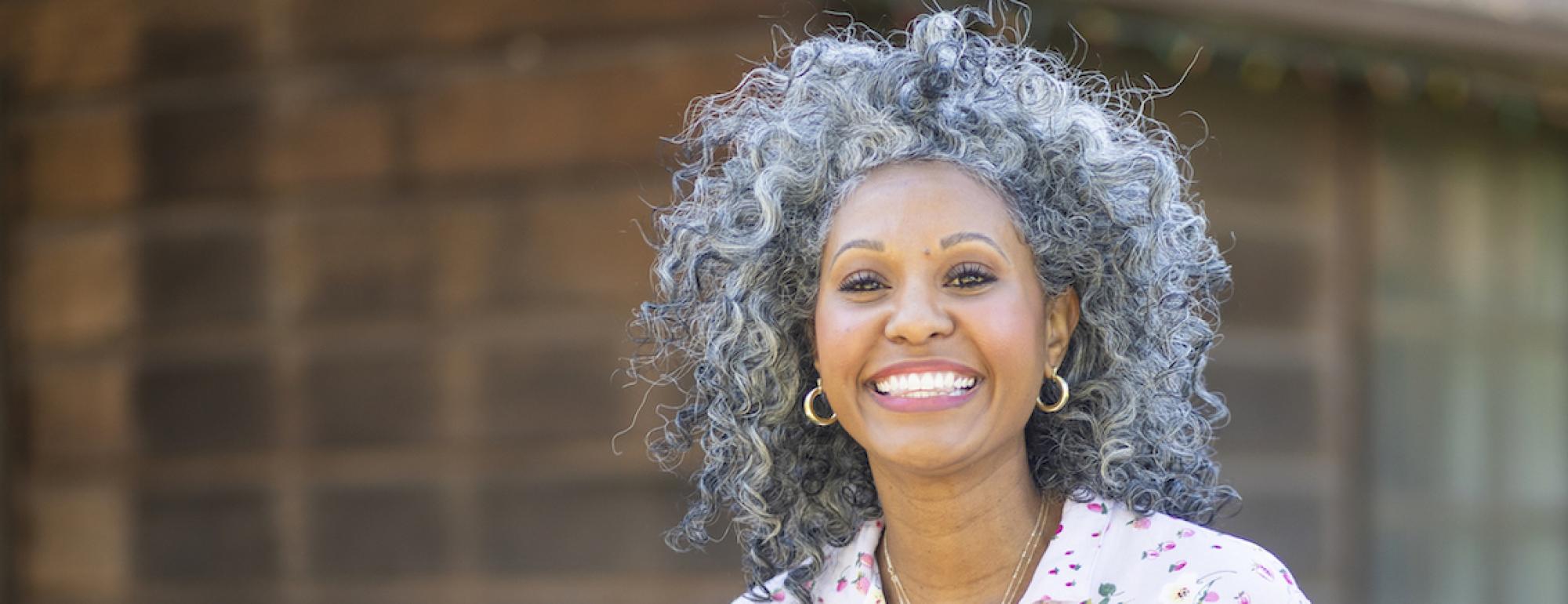Mastectomy with Reconstruction
- Total Skin Sparing Mastectomy
- Skin Sparing Mastectomy
- Breast Reconstruction Techniques
- Tissue expander and implant
- Latissimus Dorsi Flap and Implant
- Other microsurgical flaps
- Preparing for Surgery
- Post Mastectomy Pain (video)
- Download Breast Implant Reconstruction Pre- and Post-Operative Exercises
Total Skin Sparing Mastectomy and Skin Sparing Mastectomy with Immediate Reconstruction

There is an important decision to be made when thinking about having a mastectomy with immediate reconstruction between total skin sparing mastectomy where the skin of the nipple and areola are preserved and skin sparing mastectomy where the skin of the nipple and areola are not saved. The decision about which method is used is based on the extent and position of your breast cancer, your health, your body type and your preference.
Total Skin Sparing Mastectomy
A total skin sparing mastectomy preserves the breast skin and the skin of the nipple and areola by removing the breast tissue from underneath. The breast tissue under the skin of the nipple and areola is NOT saved. The following considerations limit the successful outcome of this procedure: breast cancer in or very close to your nipple or in a lot of your skin, being an active smoker, or having large, pendulous breasts. Even if it is medically safe or possible to do the procedure, some women elect not to have it done. This procedure is not universally available in all centers. For a graphic illustration of steps involved in total skin sparing mastectomy with immediate reconstruction, click here (graphic in pdf form).
If you are interested in learning more about how total skin-sparing techniques affected outcomes positively at UCSF, please see Total Skin-Sparing Mastectomy: Complications and Local Recurrence Rates in 2 Cohorts of Patients, from Ann Surg 2009, 249: 26-31 (article in PDF form).
Skin Sparing Mastectomy
A skin sparing mastectomy preserves the skin of the breast but does not preserve the skin of the nipple and areola. After the first surgery, there will be a scar over the center of the breast. A second surgery is required to recreate the nipple. Following that, the nipple and areola are then tattooed in an office visit. For a depiction of the steps involved in a skin sparing mastectomy with a tissue expander, click here (graphic in pdf form).
Breast Reconstruction Techniques
Breast reconstruction techniques can be paired with the mastectomy. A total skin-sparing mastectomy (preserving the skin of your nipple and areola) may be an option for you with tissue expander, lattisimus dorsi flap or TRAM. A total skin-sparing mastectomy is not considered a good option with a DIEP flap. A skin-sparing mastectomy is an option in concert with a tissue expander, latissimus dorsi flap, TRAM or DIEP flap.
Tissue expander and implant
In this method, a tissue expander is placed under your chest muscles (these muscles have no change in function after recovery from surgery). The expander is then inflated every 2-3 weeks for about 3-4 months. This inflation requires a visit to the plastic surgeon who injects salt water into the expander using a needle. There is some temporary (1-4 hours) chest tightness after each procedure. When expansion is finished, it is generally painless. Then, in 3-6 months when the chest skin is stretched enough (like a woman's abdomen stretches during pregnancy) the expander is removed and a permanent saline (salt water) implant that matches your other breast is put in. This involves a second, relatively minor operation. Then, if you wish, the nipple is reconstructed in a third, minor operation. The last step in the total skin sparing process includes tattooing of the nipple and areola.
Your plastic surgeon or nurse can show you these expanders and implants when you are in the office. These implants now come in a very wide range of shapes and sizes, so that a woman's opposite breast can be closely matched.
The advantages of this surgery are that it is the simplest reconstructive method and all of the surgeries are relatively minor.
The disadvantages of this type of reconstruction include a longer mastectomy scar and 2-3 operations (one of which is done at the same time as the mastectomy if you have immediate reconstruction). Also, you must go to your plastic surgeon's office every 2-3 weeks to have your expander inflated. In addition, initially after surgery, there is really no breast shape until after the expander has been inflated a few times. This technique may not be possible in some patients who will receive radation therapy treatment, because the radiation can cause hardening of the implant. The reconstructed breast always feels hard and often tight, and will never droop naturally. Finally, some women prefer a more natural reconstruction using their own tissues to create a breast.
Latissimus Dorsi Flap and Implant
 In this method, a permanent implant is placed and the latissmus muscle and some skin from the back are used to create a beast in one operation. Unless a woman is very small breasted, latissimus flap reconstruction always requires an implant. The muscle used is one that is "replaced" by other muscles so that the majority of women report that after surgical recovery, they adapt comfortably and are able to do the important physical activities that they were able to do before surgery . Scarring and healing can be improved with massage and post-operative exercises. Again, a permanent implant matched carefully to your other breast is used.
In this method, a permanent implant is placed and the latissmus muscle and some skin from the back are used to create a beast in one operation. Unless a woman is very small breasted, latissimus flap reconstruction always requires an implant. The muscle used is one that is "replaced" by other muscles so that the majority of women report that after surgical recovery, they adapt comfortably and are able to do the important physical activities that they were able to do before surgery . Scarring and healing can be improved with massage and post-operative exercises. Again, a permanent implant matched carefully to your other breast is used.
The advantage of this surgery is that it requires one operation and has a much smaller breast scar. A second, very minor surgery is necessary if you would like your nipple reconstructed as well. This procedure may be done for women who have had radiation therapy treatments to the breast.
The disadvantage of this type of surgery include a long back scar. The scar, however, can be designed to be hidden by your bra or a one piece bathing suit. This surgery is somewhat more painful than expander surgery. However, some women prefer a more natural reconstruction using their own tissues, without an implant to create a breast. In this case, TRAM reconstruction may be preferable.
 The latissimus dorsi flap can be done in concert with skin-sparing mastectomy or total skin-sparing mastectomy. The latissimus dorsi flap uses skin and muscle from the back to cover the implant and thereby reconstruct the breast.
The latissimus dorsi flap can be done in concert with skin-sparing mastectomy or total skin-sparing mastectomy. The latissimus dorsi flap uses skin and muscle from the back to cover the implant and thereby reconstruct the breast.
Other microsurgical flaps
Depending on your body habitus and medical history, breast reconstruction may be performed with tissue from parts of your body other than your abdomen, including your thigh or buttocks.
- SIEA flap = Superficial Inferior Epigastric Artery Flap. With this operation, no incisions are made in the abdominal muscle, as all vessels are taken from a more superficial location.If you have had a pervious major abdominal surgery such as an abdominoplasty (tummy tuck), or if you do not have enough tissue on your lower abdomen to reconstruct your breast we can also use tissue from your buttocks or inner thighs. Previous cesarean sections do not limit our ability to use the tissue of the lower abdomen.
- S-GAP flap = Superior Gluteal Artery Perforator Flap. With this operation, the upper portion of your buttock skin and fat is taken.
- I-GAP flap = Inferior Gluteal Artery Perforator Flap. With this operation, the lower portion of your buttock skin and fat is taken.
- TUG/TMG flap = Transverse Upper Gracilis or Transverse Myocutaneous Gracilis Flap. With this operation, the upper portion of your thigh skin and fat are taken. A small muscle on the inside of your thigh is alos used, to carry the blood supply and add more bulk to the reconstructed breast.
Post Mastectomy Pain (Video)
 There is a syndrome of pain postoperatively that you may experience. If so, it is often easily treated and we strongly recommend you bring this complaint to your physician or NP. The injection procedure demonstrated in this video is designed to reduce post operative pain in some patients.
There is a syndrome of pain postoperatively that you may experience. If so, it is often easily treated and we strongly recommend you bring this complaint to your physician or NP. The injection procedure demonstrated in this video is designed to reduce post operative pain in some patients.
Download Post Mastectomy Injection Video (note: graphic content)
Preparing for Surgery
To shorten your recovery time from a breast reconstructive surgery, you may want to familiarize yourself with and follow the suggestions for physical pre- and post-operative exercises below.
Download Breast Implant Reconstruction Pre- and Post-Operative Exercises
